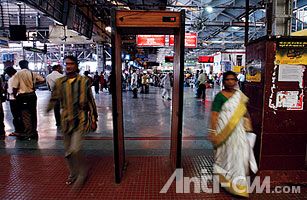|
|
本帖最后由 I'm_zhcn 于 2009-11-22 14:18 编辑
India's Urban Legend
http://www.time.com/time/magazine/article/0,9171,1940549,00.html
By Jyoti Thottam Monday, Nov. 30, 2009

Security gap
Ignoring a metal detector at Victoria Terminus RUTH FREMSON / The New York Times / Redux
On foot, even a city of 18 million people can feel like a village. I was reminded of this during the attacks on Mumbai a year ago, when the only way to get around was by walking. For three days, my world shrank to a tiny patch of the city's southern tip as I trudged through seemingly endless loops between the places where a handful of terrorists had holed themselves up before they were killed by commandos. The curving path from Nariman House back to my hotel is imprinted on my memory, along with the kindness of the stranger who gave me water from his own bottle when I was nearing exhaustion and the shops were all closed. As the blasts and grenades went off, the streets and the people began to feel familiar and, somehow, safe.
India's long neglect of its cities was never more painfully obvious than during the Nov. 26, 2008, attacks. The civil administration in Mumbai was utterly unable to manage the crisis and all but abdicated that responsibility to the Army. The central government eventually ended the siege of Mumbai, but its failures — to heed early warnings or secure the city's borders — were just as galling. So perhaps it was with a villager's stubborn pride that I thought Mumbai, a high-octane, rough-and-tumble metropolis, would become a kinder, gentler and altogether better place to live and work in the wake of 11/26. (See pictures of the first two days of attacks in Mumbai.)
Certainly that's what the city's residents demanded, and what officialdom pledged. More than the ubiquitous candlelight vigils, the anger and frustration that I heard from ordinary people in Mumbai, and later in India's other big cities, seemed new. They resolved to demand more from their politicians — better services and real accountability — and from themselves. Instead of just dusting themselves off and getting back to work, many promised to complain less, volunteer more and take the trouble to vote. Swati Ramanathan, whose Bangalore-based group Janaagraha led an ambitious national voter-registration drive, told me shortly before the general elections earlier this year that the attacks had jolted India's cities out of complacency. "The tide is turning," she said.
The Indian government matched that optimism with the grandly named Jawaharlal Nehru National Urban Renewal Mission, which has so far allocated more than $11 billion in long-overdue funds to fix India's cities. The money — for roads, sewer lines and mass-transit systems — comes with some very important strings attached. To get the money, state governments have to devolve more power to cities; and city governance would go hyper-local, giving some control over the spending to new, elected neighborhood councils. (See pictures of the tempestuous Nehru-Gandhi dynasty of India.)
But what has actually happened has fallen far short of that promise. In Mumbai, luxury hotels have certainly tightened up security, but at Victoria Terminus, the deadliest site of the attacks, the new metal detectors are almost comically inadequate. The flimsy contraptions are no match for millions of commuters, who swarm through and around them undeterred as they shake with the surge of the crowd. During this year's national elections, urban voter turnout remained well below that of the villages, and none of the reform-minded independents who ran for Parliament won more than 2% of the vote — including the outspoken, idealistic banker Meera Sanyal, who ran in south Mumbai. R.R. Patil, a Maharashtra state politician who resigned when his remark that Mumbai's death toll could have been worse sparked public outrage, is back in office — once again in charge of security. The state has claimed $100 million in urban-renewal funds for Mumbai, but watered down the governance reforms to make them almost meaningless.
If India wants to honor the famously resilient spirit of Mumbai, it could begin by acknowledging that India no longer "lives in its villages" as Mahatma Gandhi said it did — at least not in the same way. Town and country are more connected than ever. Most of India's wealth is created in its cities, generating the tax revenues that fund the schools, electricity and clean water villages need so desperately. More than 70% of the country may still live in rural areas, but over the next decade, that will drop to 60%. Having a son or father working in the city is already as much a part of village life as praying for a good monsoon.
All of India — including its villages — needs cities that work. Ramanathan, for one, is trying to organize neighborhood-watch committees in Mumbai, an effort slowed considerably by the resistance of the local police. To revitalize India's cities, the country needs a new vision of itself — and a government committed to the hard work of making it real.
Read "How India's Young and Restless Are Changing Its Politics."
Read "Mumbai's Fallout: Will India's Government Survive?"

|
India, Legend, Urban, 时代周刊, India, Legend, Urban, 时代周刊, India, Legend, Urban, 时代周刊
|